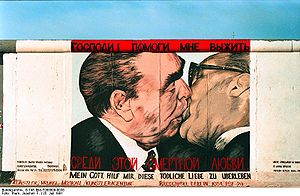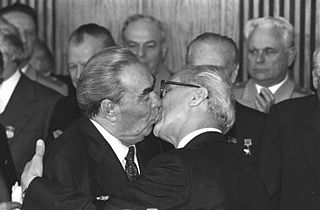- My God, Help Me to Survive This Deadly Love
-
My God, Help Me to Survive This Deadly Love 
Artist Dmitri Vrubel Year 1990 Type Graffiti Dimensions 3650 cm × 4800 cm (1437 in × 1889 in) Location East Side Gallery, East Berlin, German Democratic Republic Does not exist any longer. Reproduction available at Mühlenstraße 33, Berlin 52°30′28″N 13°26′07″E / 52.507876°N 13.435163°ECoordinates: 52°30′28″N 13°26′07″E / 52.507876°N 13.435163°E
Owner In public domain My God, Help Me to Survive This Deadly Love (Russian: «Господи! Помоги мне выжить среди этой смертной любви», German: Mein Gott, hilf mir, diese tödliche Liebe zu überleben), sometimes referred to as the Fraternal Kiss (German: Bruderkuß), is a graffiti painting on the Berlin wall by Dmitri Vrubel, one of the best known of the Berlin wall graffiti paintings. Created in 1990, the painting depicts Leonid Brezhnev and Erich Honecker in a fraternal embrace, reproducing a photograph that captured the moment in 1979 during the 30th anniversary celebration of the foundation of the German Democratic Republic. The painting was destroyed in March 2009.
Contents
The photograph
The iconic photograph capturing the famed embrace was snapped by Regis Bossu in East Berlin on October 7, 1979.[1] The photograph was widely republished.[2] Brezhnev was visiting East Germany at the time to celebrate its founding as a Communist nation.[3] On October 5th, East Germany and the Soviet Union had signed a ten year agreement of mutual support under which East Germany would provide ships, machinery and chemical equipment to the Soviet Union and the Soviet Union would provide fuel and nuclear equipment to East Germany.[4]
Currently, the photo is a courtesy of Corbis Corporation.[1]
The painting
Vrubel created the painting in 1990. Along with other murals in the section, the painting continued in display after the wall was taken down, but vandalism and atmospheric conditions gradually led to its deterioration.[5] In March 2009, the painting was destroyed, steamed off of the wall along with others to allow the original artists to repaint them with more durable paints. Vrubel was comissioned to repaint the piece, donating the €3000 fee he was paid to a social art project in Marzahn.[2]
Photographer Bossu and Vrubel met in 2009 and were photographed together on 16 June with reproductions of their works.[2][6]
Critical reception to the painting
My God, Help Me to Survive This Deadly Love became one of the best known works of graffiti art on the Berlin Wall.[7][8] According to Anthony Read and David Fisher, the painting is "particularly striking, with a sharp, satirical edge."[9] However, it was also widely criticized on creation as a straightforward reproduction of the photograph which inspired it.[10]
References
- ^ a b "Kiss of Soviet Leader Brezhnev and East German President Honecker". Corbis. http://www.corbisimages.com/stock-photo/rights-managed/42-21927891/kiss-of-soviet-leader-brezhnev-and-east. Retrieved 22 November 2011Soviet leader Leonid Brezhnev and East German President Erich Honecker kiss on the occasion of the 30th anniversary of the German Democratic Republics.
- ^ a b c Clemens, Jochen (November 22, 2009). "Die längste Open-Air-Galerie der Welt. Die Geschichte eines Gemäldes: Der Bruderkuss [The story of a painting: The brother kiss]" (in German). Welt Online. http://www.welt.de/sonderveroeffentlichung/landderideen/article4925486/Die-laengste-Open-Air-Galerie-der-Welt.html.
- ^ Vinocur, John (October 5, 1979). "Brezhnev Arrives in East Germany For 30th Anniversary Celebration; Ceausescu Is Not Expected". The New York Times (East Berlin: The New York Times Company): p. A8. ISSN 0362-4331. OCLC 1645522. http://select.nytimes.com/gst/abstract.html?res=F70A16FF355511728DDDAC0894D8415B898BF1D3&scp=21&sq=.
- ^ Vinocur, John (October 6, 1979). "Soviet and East Germans Sign an Economic Pact". The New York Times (East Berlin: The New York Times Company): p. 30. ISSN 0362-4331. OCLC 1645522. http://select.nytimes.com/gst/abstract.html?res=F40F16FA3F5C11728DDDAF0894D8415B898BF1D3&scp=29&sq=.
- ^ Göbel, Malte (March 27, 2009) "Kiss of Death. Officials Erase Historic Berlin Wall Mural" Der Spiegel online http://www.spiegel.de/international/germany/0,1518,615900,00.html
- ^ Schwarz, Tobias (Jun 16th, 2009). "Russian artist Dmitry Vrubel and photographer Regis Bossu pose before restoration work on a segment of the East Side Gallery" (HTML). Reuters. Berlin: 2space. http://www.2space.net/news/article/205379-1245158535/.
- ^ Major, Patrick (2009). Behind the Berlin Wall: East Germany and the frontiers of power. Oxford, New York: Oxford University Press. p. 276. ISBN 978-0-19-924328-0. http://books.google.de/books?id=YJj3ylisBFEC&printsec=frontcover&hl=ru#v=onepage&q&f=false.
- ^ Tagliabue, John (April 7, 1991). "What divides Berlin now?". The New York Times Magazine (N. Y.: The New York Times Company). ISSN 0362-4331. OCLC 1645522. http://www.nytimes.com/1991/04/07/magazine/what-divides-berlin-now.html?scp=14&sq=.
- ^ Read, Anthony; Fisher, David (1994). Berlin: the biography of a city. London: Hutchinson. p. 308. ISBN 978-0-091-78021-0.
- ^ Minaev, Boris (October 27, 2003). "Дмитрий Врубель дважды попадал под колесо истории: Когда нарисовал целующихся Брежнева и Хонеккера на Берлинской стене и когда начал рисовать Владимира Путина [Dmitri Vrubel got himself twice upon the wheel of history: When portrayed Brezhnev kissing Honecker on the Berlin Wall, and when began to paint Vladimir Putin]" (in Russian). Ogonyok (Moscow: Pravda) (39): 41. ISSN 0131-0097. OCLC 1761076. http://www.ogoniok.com/archive/2003/4818/39-40-42/. "Многие тогда говорили: да какая это картина, просто взял и перерисовал фотографию, но тем не менее это была картина, причем великая, и у нее было название, между прочим — «Господи, помоги мне выжить среди этой смертной любви»"
Categories:- Berlin Wall
- Destroyed landmarks
- Eastern Bloc
- Graffiti and unauthorised signage
- Leonid Brezhnev
- 1990 works
Wikimedia Foundation. 2010.

